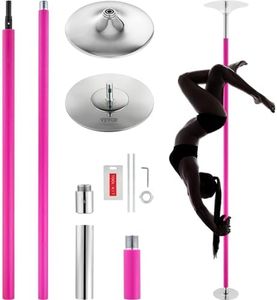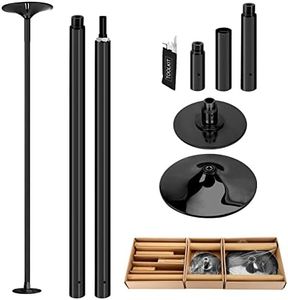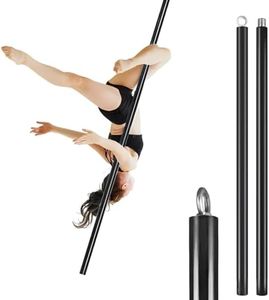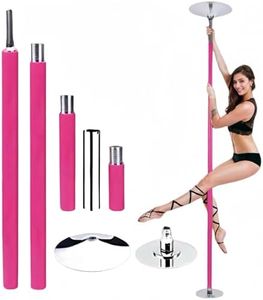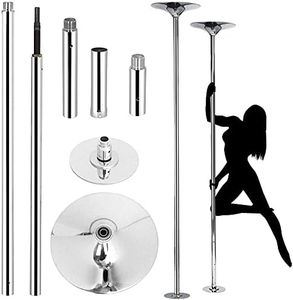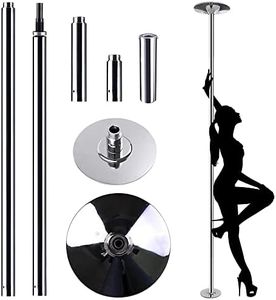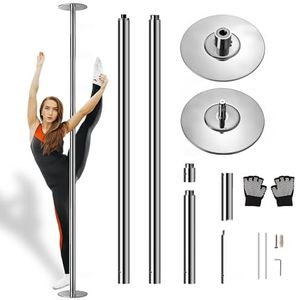We Use CookiesWe use cookies to enhance the security, performance,
functionality and for analytical and promotional activities. By continuing to browse this site you
are agreeing to our privacy policy
10 Best Pole Dancing Pole
From leading brands and best sellers available on the web.Buying Guide for the Best Pole Dancing Pole
Choosing the right pole dancing pole can make all the difference in your practice, whether you're a beginner or have more experience. The right pole gives you safety, stability, and comfort while you learn techniques or improve your skills. To make a smart choice, it's important to look at key features—the specifications—of poles on the market and figure out which ones fit your needs best. Each spec affects your experience, so understanding each one will help you pick a pole that is safe, enjoyable, and suited for your space and routine.DiameterDiameter refers to the thickness of the pole, usually measured in millimeters. The most common sizes are 40mm, 45mm, and 50mm. A thinner pole (like 40mm) provides a better grip and is easier for those with smaller hands, which can help when learning new moves. A 45mm diameter is standard in most studios and competitions, making it a versatile choice for those who want to match professional standards. The 50mm diameter is better suited for those already comfortable with gripping, offering more surface area but may be harder for smaller hands. To choose the right one, consider your hand size and what feels comfortable, or match what you use in classes.
MaterialPole materials include chrome, stainless steel, brass, and powder-coated finishes. Each material affects grip, durability, and feel. Chrome is affordable and common, but may be slippery for sweaty hands. Stainless steel is good for people with allergies or those who prefer to use the pole outdoors, since it resists rust, but it can be slick. Brass provides a warmer feel and better natural grip—great for humid environments. Powder-coated poles offer an excellent grip, helpful for beginners, but can wear over time. Your choice should reflect your environment (humidity, allergies) and skin sensitivity, as well as your level of confidence with grip.
Spinning vs. Static ModePoles can be static (fixed in place) or spinning (rotate freely). Many modern poles allow both modes through an easy switch. Static poles don’t move, so they are easier for learning foundational holds and strength moves, while spinning poles create dynamic movement for more advanced tricks. Beginners usually start on static, but having both options means you can progress to more advanced moves over time. Choose based on your goals—if you want to learn multiple styles, consider a dual-mode pole.
Height AdjustabilityNot all ceilings are the same height, so adjustability is crucial. Many poles come with extensions that let the pole fit different ceiling heights, often within a set range. A pole with a wider adjustment range is useful if you plan to move it or use it in different rooms. Check your ceiling height at home before you purchase and make sure your pole can safely fit your available space.
Portability and InstallationPortability refers to how easy it is to set up, take down, or move the pole. Some are permanent (fixed to the ceiling and floor), while others are pressure-mounted and can be moved without leaving marks. If you need to hide your pole or take it to different locations, look for a removable or portable option, but always make sure it remains stable and safe when installed. Think about whether you’ll use the pole in a single spot or need flexibility.
Weight CapacityThis is the maximum recommended weight the pole can hold. Higher capacity means increased safety, especially for dynamic moves where more force is applied. Most quality poles have high weight limits, but it's important to check that the pole can safely support your body and any moves you plan to perform. This is particularly important if you plan to share the pole or use it for acrobatic tricks.
Ceiling/Floor Type CompatibilitySome poles require specific types of surfaces for safe installation, like solid wooden beams or concrete ceilings, while others are more flexible. Knowing your ceiling and floor type is essential for safety—improper installation on the wrong surface can be dangerous. Verify before buying that the pole’s mounting mechanism is compatible with your home’s surfaces.
